Characterization of Open-Cell Sponges via Magnetic Resonance and X-ray Tomography
Abstract
1. Introduction
2. Materials and Methods
2.1. X-ray Computed Tomography
2.2. Magnetic Resonance
2.3. Statistical Analysis
3. Results
4. Discussion
5. Conclusions
Author Contributions
Funding
Institutional Review Board Statement
Informed Consent Statement
Data Availability Statement
Acknowledgments
Conflicts of Interest
Appendix A

References
- Aubert, J.; Clough, R. Low-density, microcellular polystyrene foams. Polymer 1985, 26, 2047–2054. [Google Scholar] [CrossRef]
- Fossey, D.; Smith, C. Fabrication of Open-Cell Polyethylene Foam. J. Cell. Plast. 1973, 9, 268–273. [Google Scholar] [CrossRef]
- Starry, G.L. Sponge Cleaning Device. U.S. Patent 3,345,669, 10 October 1967. [Google Scholar]
- Ma, Q.; Cheng, H.; Fane, A.G.; Wang, R.; Zhang, H. Recent development of advanced materials with special wettability for selective oil/water separation. Small 2016, 12, 2186–2202. [Google Scholar] [CrossRef]
- Kumaran, M.; Bomberg, M. Thermal performance of sprayed polyurethane foam insulation with alternative blowing agents. J. Therm. Insul. 1990, 14, 43–57. [Google Scholar] [CrossRef]
- Jones, V.; Grey, J.E.; Harding, K.G. Wound dressings. BMJ 2006, 332, 777–780. [Google Scholar] [CrossRef] [PubMed]
- Pollak, A.N. Use of negative pressure wound therapy with reticulated open cell foam for lower extremity trauma. J. Orthop. Trauma 2008, 22, S142–S145. [Google Scholar] [CrossRef] [PubMed]
- Menges, G.; Knipschild, F. Estimation of mechanical properties for rigid polyurethane foams. Polym. Eng. Sci. 1975, 15, 623–627. [Google Scholar] [CrossRef]
- Yong, W.; Jie, L. Use of polyurethane foams complex material to preserve moisture and fertility. Polym. Plast. Technol. Eng. 2007, 46, 943–947. [Google Scholar] [CrossRef]
- Llabres, C.M.; Rose, B.E. Antibacterial properties of retail sponges. J. Food Prot. 1989, 52, 49–50. [Google Scholar] [CrossRef] [PubMed]
- Gong, L.; Kyriakides, S.; Jang, W.-Y. Compressive response of open-cell foams. Part I: Morphology and elastic properties. Int. J. Solids Struct. 2005, 42, 1355–1379. [Google Scholar] [CrossRef]
- Gama, N.V.; Ferreira, A.; Barros-Timmons, A. Polyurethane foams: Past, present, and future. Materials 2018, 11, 1841. [Google Scholar] [CrossRef]
- Ashida, K. Polyurethane and Related Foams: Chemistry and Technology; CRC Press: Boca Raton, FL, USA, 2006. [Google Scholar]
- Lee, S.-T.; Ramesh, N.S. Polymeric Foams: Mechanisms and Materials; CRC Press: Boca Raton, FL, USA, 2004. [Google Scholar]
- Blazejczyk, A. Morphometric Analysis of One-Component Polyurethane Foams Applicable in the Building Sector via X-ray Computed Microtomography. Materials 2018, 11, 1717. [Google Scholar] [CrossRef]
- Van Brakel, J.; Modrý, S.; Svata, M. Mercury porosimetry: State of the art. Powder Technol. 1981, 29, 1–12. [Google Scholar] [CrossRef]
- Ziel, R.; Haus, A.; Tulke, A. Quantification of the pore size distribution (porosity profiles) in microfiltration membranes by SEM, TEM and computer image analysis. J. Membr. Sci. 2008, 323, 241–246. [Google Scholar] [CrossRef]
- Cnudde, V.; Boone, M.N. High-resolution X-ray computed tomography in geosciences: A review of the current technology and applications. Earth Sci. Rev. 2013, 123, 1–17. [Google Scholar] [CrossRef]
- Withers, P.J.; Bouman, C.; Carmignato, S.; Cnudde, V.; Grimaldi, D.; Hagen, C.K.; Maire, E.; Manley, M.; Du Plessis, A.; Stock, S.R. X-ray computed tomography. Nat. Rev. Methods Primers 2021, 1, 18. [Google Scholar] [CrossRef]
- Marica, F.; Chen, Q.; Hamilton, A.; Hall, C.; Al, T.; Balcom, B. Spatially resolved measurement of rock core porosity. J. Magn. Reson. 2006, 178, 136–141. [Google Scholar] [CrossRef] [PubMed]
- Ho, S.T.; Hutmacher, D.W. A comparison of micro CT with other techniques used in the characterization of scaffolds. Biomaterials 2006, 27, 1362–1376. [Google Scholar] [CrossRef]
- Yao, Y.; Liu, D. Comparison of low-field NMR and mercury intrusion porosimetry in characterizing pore size distributions of coals. Fuel 2012, 95, 152–158. [Google Scholar] [CrossRef]
- Swapp, S. Scanning Electron Microscopy. Available online: https://serc.carleton.edu/research_education/geochemsheets/techniques/SEM.html (accessed on 10 July 2020).
- Bang, S.S.; Galinat, J.K.; Ramakrishnan, V. Calcite precipitation induced by polyurethane-immobilized Bacillus pasteurii. Enzyme Microb. Technol. 2001, 28, 404–409. [Google Scholar] [CrossRef]
- Wu, D.; Wu, W.; Yu, Z.; Zhang, C.; Zhu, H. Facile preparation and characterization of modified polyurethane sponge for oil absorption. Ind. Eng. Chem. Res. 2014, 53, 20139–20144. [Google Scholar] [CrossRef]
- Souza, D.A.d.; Araujo, D.M.d.; Carvalho, C.d.F.; Yoshida, M.I. Physico-chemical analysis of flexible polyurethane foams containing commercial calcium carbonate. Mater. Res. 2008, 11, 433–438. [Google Scholar]
- Peng, S.; Hu, Q.; Dultz, S.; Zhang, M. Using X-ray computed tomography in pore structure characterization for a Berea sandstone: Resolution effect. J. Hydrol. 2012, 472, 254–261. [Google Scholar] [CrossRef]
- Maire, E.; Withers, P.J. Quantitative X-ray tomography. Int. Mater. Rev. 2014, 59, 1–43. [Google Scholar] [CrossRef]
- Long, H.; Swennen, R.; Foubert, A.; Dierick, M.; Jacobs, P. 3D quantification of mineral components and porosity distribution in Westphalian C sandstone by microfocus X-ray computed tomography. Sediment. Geol. 2009, 220, 116–125. [Google Scholar] [CrossRef]
- Brabant, L.; Vlassenbroeck, J.; De Witte, Y.; Cnudde, V.; Boone, M.N.; Dewanckele, J.; Van Hoorebeke, L. Three-dimensional analysis of high-resolution X-ray computed tomography data with Morpho+. Microsc. Microanal. 2011, 17, 252–263. [Google Scholar] [CrossRef]
- Khosravani, M.R.; Reinicke, T. On the Use of X-ray Computed Tomography in Assessment of 3D-Printed Components. J. Nondestr. Eval. 2020, 39, 1–17. [Google Scholar] [CrossRef]
- Shastry, A.; Palacio-Mancheno, P.; Braeckman, K.; Vanheule, S.; Josipovic, I.; Van Assche, F.; Robles, E.; Cnudde, V.; Van Hoorebeke, L.; Boone, M. In-Situ High Resolution Dynamic X-ray Microtomographic Imaging of Olive Oil Removal in Kitchen Sponges by Squeezing and Rinsing. Materials 2018, 11, 1482. [Google Scholar] [CrossRef]
- Bultreys, T.; Boone, M.A.; Boone, M.N.; De Schryver, T.; Masschaele, B.; Van Hoorebeke, L.; Cnudde, V. Fast laboratory-based micro-computed tomography for pore-scale research: Illustrative experiments and perspectives on the future. Adv. Water Resour. 2016, 95, 341–351. [Google Scholar] [CrossRef]
- Flay, N.; Brown, S.; Sun, W.; Blumensath, T.; Su, R. Effects of off-focal radiation on dimensional measurements in industrial cone-beam micro-focus X-ray computed tomography systems. Precis. Eng. 2020, 66, 472–481. [Google Scholar] [CrossRef]
- Borgia, G.; Bortolotti, V.; Fantazzini, P. Changes of the local pore space structure quantified in heterogeneous porous media by 1 H magnetic resonance relaxation tomography. J. Appl. Phys. 2001, 90, 1155–1163. [Google Scholar] [CrossRef]
- Attard, J.; Carpenter, T.; Hall, L.; Davies, S.; Taylor, M.; Packer, K. Spatially resolved T1 relaxation measurements in reservoir cores. Magn. Reson. Imaging 1991, 9, 815–819. [Google Scholar] [CrossRef]
- Guillot, G.; Chardaire-Rivière, C.; Bobroff, S.; Le Roux, A.; Roussel, J.; Cuiec, L. Characterisation of wetting heterogeneities in sandstone rocks by MRI. Magn. Reson. Imaging 1994, 12, 365–368. [Google Scholar] [CrossRef]
- Merrill, M. Porosity measurements in natural porous rocks using magnetic resonance imaging. Appl. Magn. Reson. 1993, 5, 307–321. [Google Scholar] [CrossRef]
- Britton, M.M. Porous Media Studied by MRI. eMagRes 2011. [Google Scholar] [CrossRef]
- Watson, A.T.; Chang, C.P. Characterizing porous media with NMR methods. Prog. Nucl. Magn. Res. Sp. 1997, 31, 343–386. [Google Scholar] [CrossRef]
- Hürlimann, M.D. Effective gradients in porous media due to susceptibility differences. J. Magn. Reson. 1998, 131, 232–240. [Google Scholar] [CrossRef]
- Stingaciu, L.; Weihermüller, L.; Haber-Pohlmeier, S.; Stapf, S.; Vereecken, H.; Pohlmeier, A. Determination of pore size distribution and hydraulic properties using nuclear magnetic resonance relaxometry: A comparative study of laboratory methods. Water Resour. Res. 2010, 46. [Google Scholar] [CrossRef]
- Wang, R.; Pavlin, T.; Rosen, M.S.; Mair, R.W.; Cory, D.G.; Walsworth, R.L. Xenon NMR measurements of permeability and tortuosity in reservoir rocks. Magn. Reson. Imaging 2005, 23, 329–331. [Google Scholar] [CrossRef]
- Schoenfelder, W.; Gläser, H.-R.; Mitreiter, I.; Stallmach, F. Two-dimensional NMR relaxometry study of pore space characteristics of carbonate rocks from a Permian aquifer. J. Appl. Geophys. 2008, 65, 21–29. [Google Scholar] [CrossRef]
- Washburn, K.E.; Madelin, G. Imaging of multiphase fluid saturation within a porous material via sodium NMR. J. Magn. Reson. 2010, 202, 122–126. [Google Scholar] [CrossRef]
- Von Der Schulenburg, D.G.; Paterson-Beedle, M.; Macaskie, L.; Gladden, L.; Johns, M. Flow through an evolving porous media—Compressed foam. J. Mater. Sci. 2007, 42, 6541–6548. [Google Scholar] [CrossRef]
- Kleinberg, R.L. NMR well logging at Schlumberger. Concept. Magn. Reson. 2001, 13, 396–403. [Google Scholar] [CrossRef]
- Masschaele, B.; Dierick, M.; Van Loo, D.; Boone, M.N.; Brabant, L.; Pauwels, E.; Cnudde, V.; Van Hoorebeke, L. HECTOR: A 240kV micro-CT setup optimized for research. J. Phys. Conf. Ser. 2013, 463, 012012. [Google Scholar] [CrossRef]
- Vlassenbroeck, J.; Dierick, M.; Masschaele, B.; Cnudde, V.; Van Hoorebeke, L.; Jacobs, P. Software tools for quantification of X-ray microtomography at the UGCT. Nucl. Instrum. Methods Phys. Res. B 2007, 580, 442–445. [Google Scholar] [CrossRef]
- Hennig, J.; Nauerth, A.; Friedburg, H. RARE imaging: A fast imaging method for clinical MR. Magn. Reson. Med. 1986, 3, 823–833. [Google Scholar] [CrossRef] [PubMed]
- Prospa, Magritek, Wellington, New Zealand. Available online: https://magritek.com/resources/faq/ (accessed on 19 July 2020).
- Bray, J.M.; Davenport, A.J.; Ryder, K.S.; Britton, M.M. Quantitative, In Situ Visualization of Metal-Ion Dissolution and Transport Using 1H Magnetic Resonance Imaging. Angew. Chem. Int. Ed. 2016, 55, 9394–9397. [Google Scholar] [CrossRef]
- Provencher, S.W. A constrained regularization method for inverting data represented by linear algebraic or integral equations. Comput. Phys. Commun. 1982, 27, 213–227. [Google Scholar] [CrossRef]
- Law, S.J.; Britton, M.M. Sizing of reverse micelles in microemulsions using NMR measurements of diffusion. Langmuir 2012, 28, 11699–11706. [Google Scholar] [CrossRef]
- Serdahl, E. An Introduction to Graphical Analysis of Residual Scores and Outlier Detection in Bivariate Least Squares Regression Analysis. Eric 1996, ED395949, 29. [Google Scholar]
- IBM Corp. IBM SPSS Statistics for Macintosh, 25.0; IBM Corp: Armonk, NY, USA, 2017. [Google Scholar]
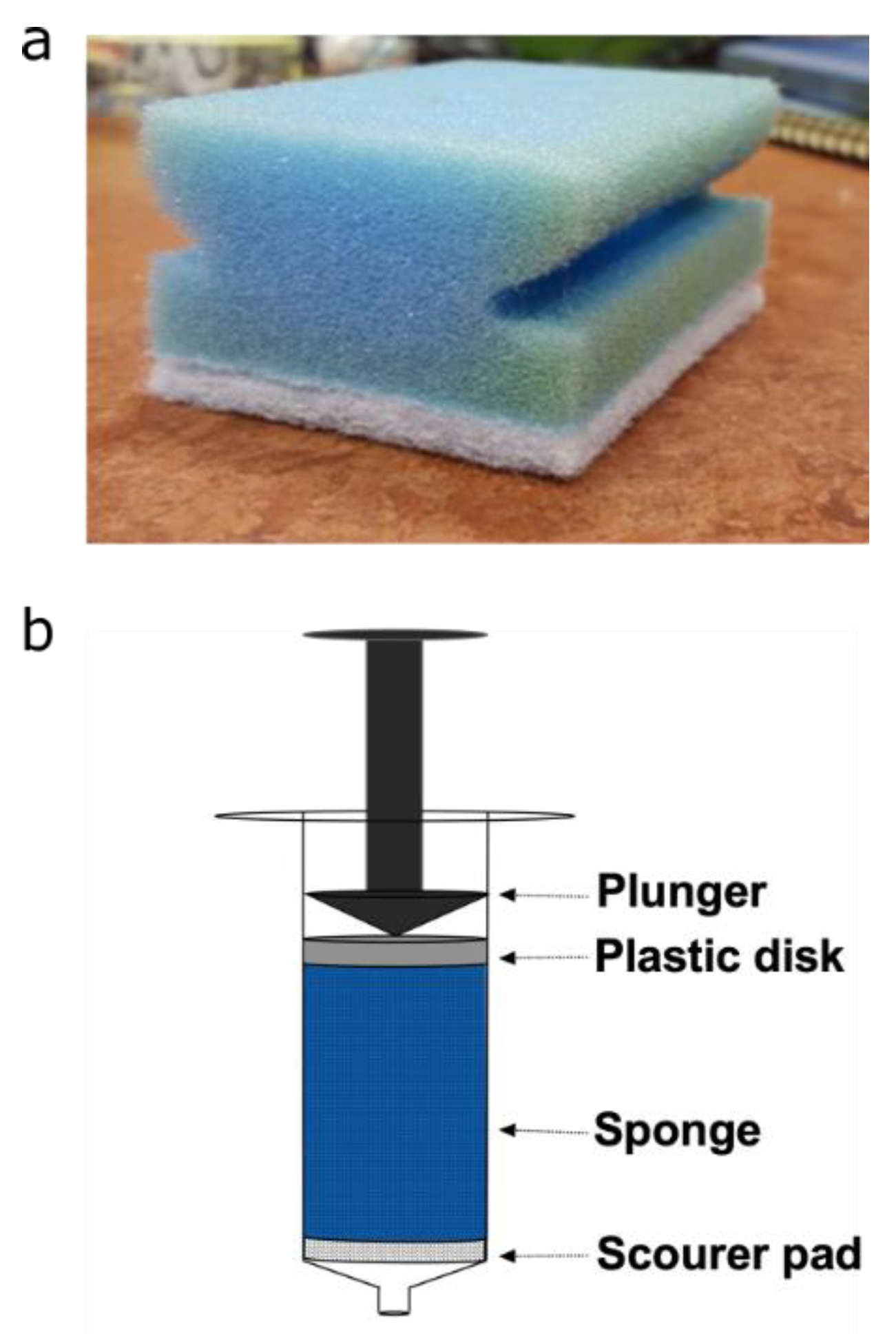

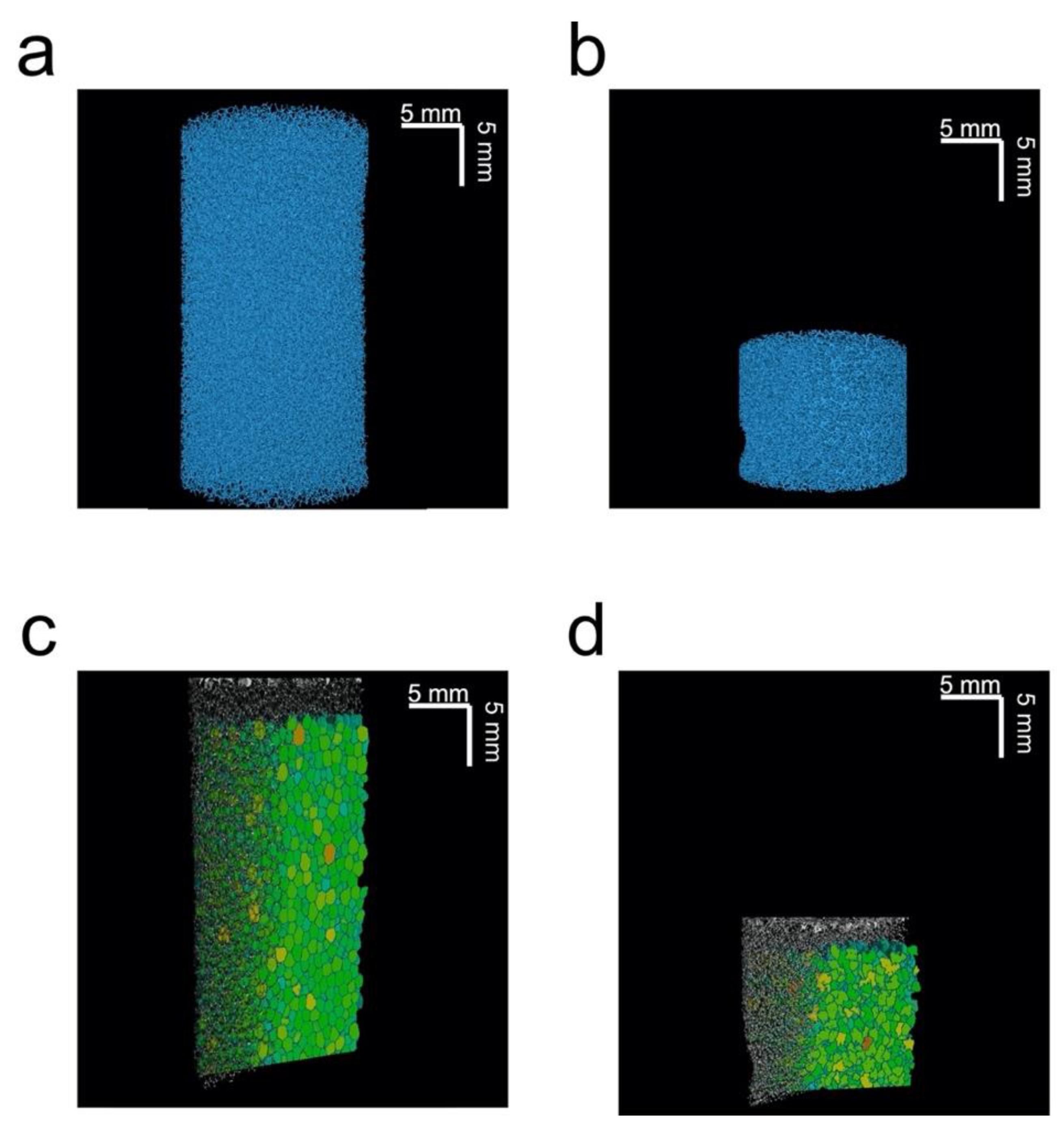
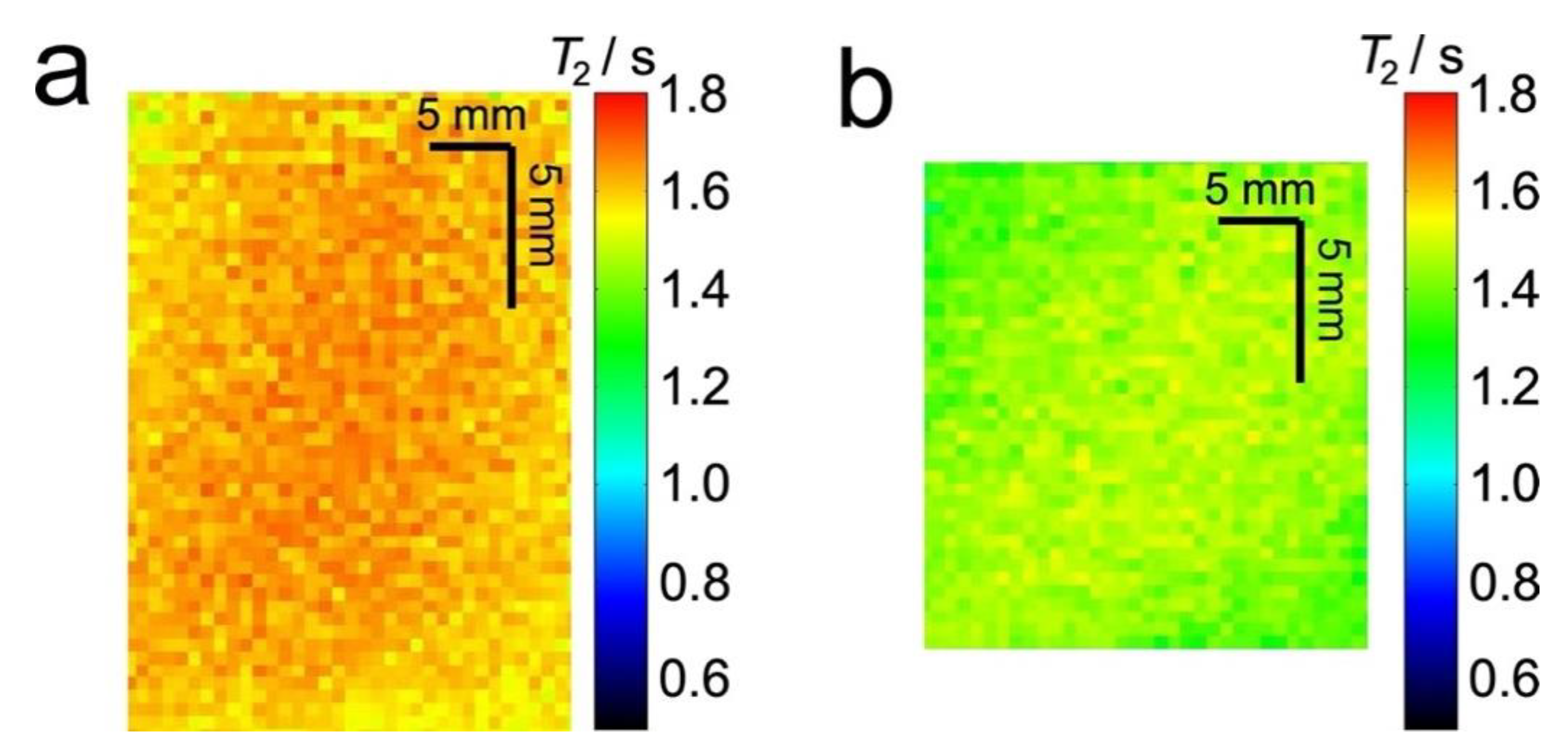
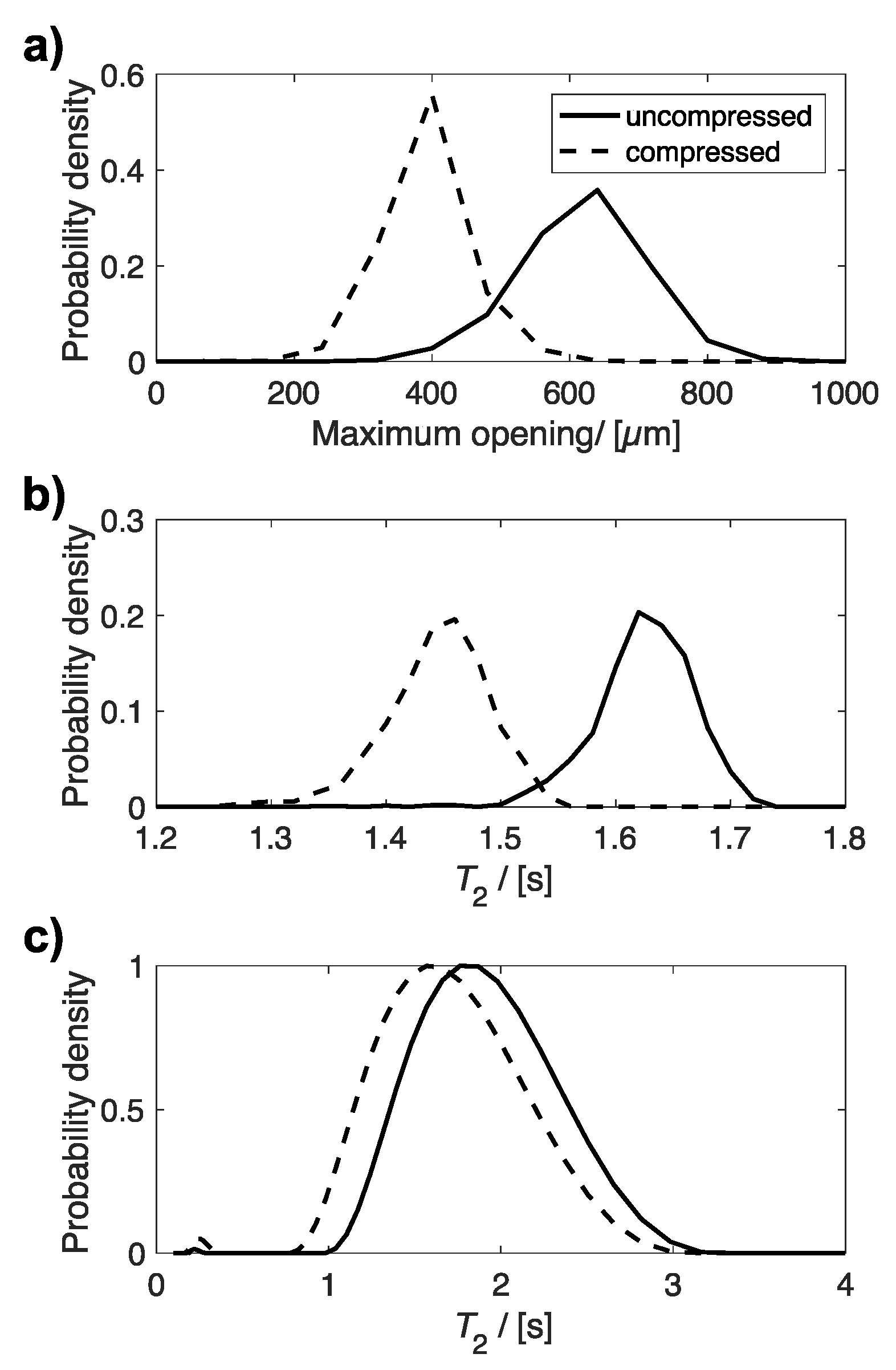
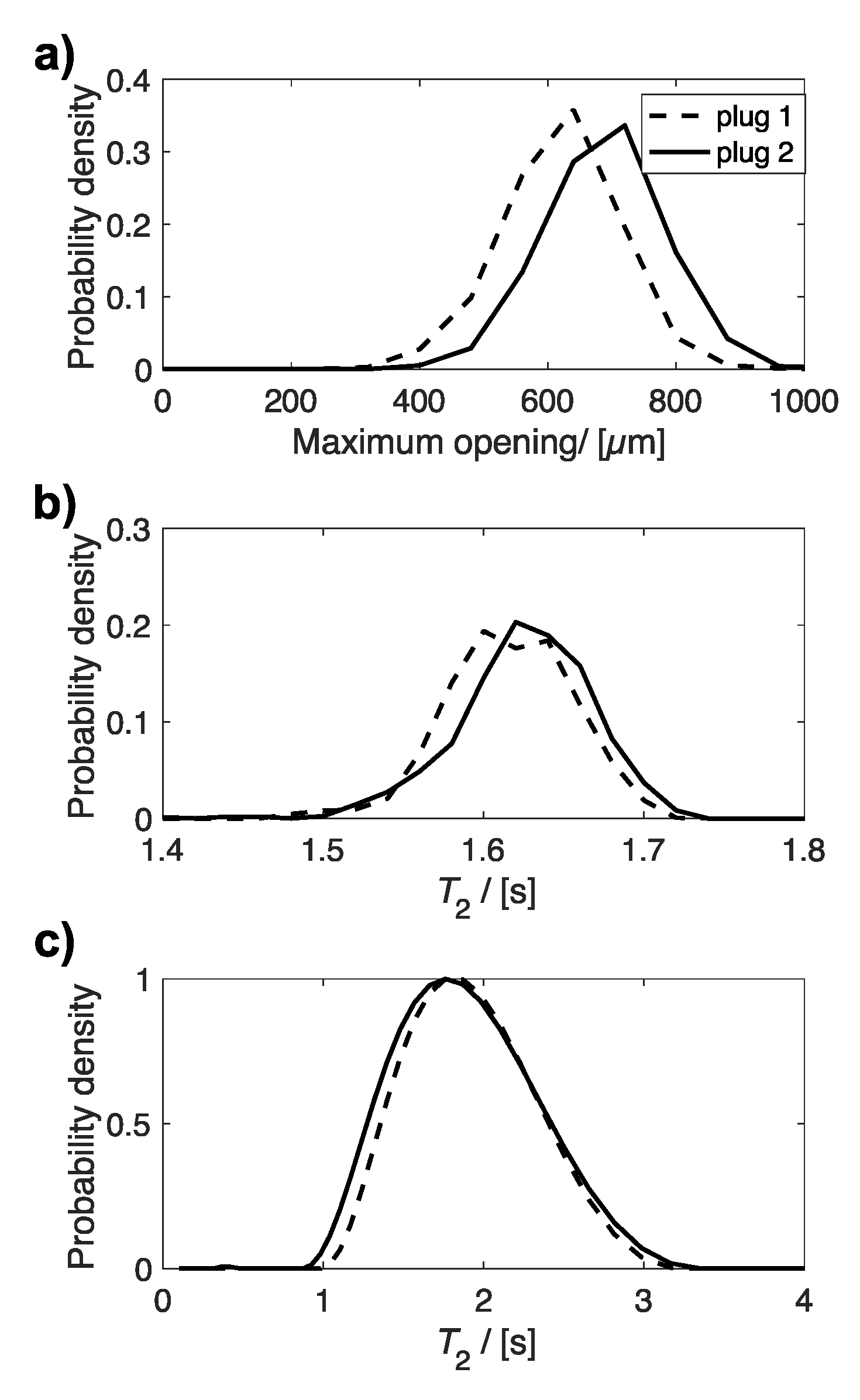
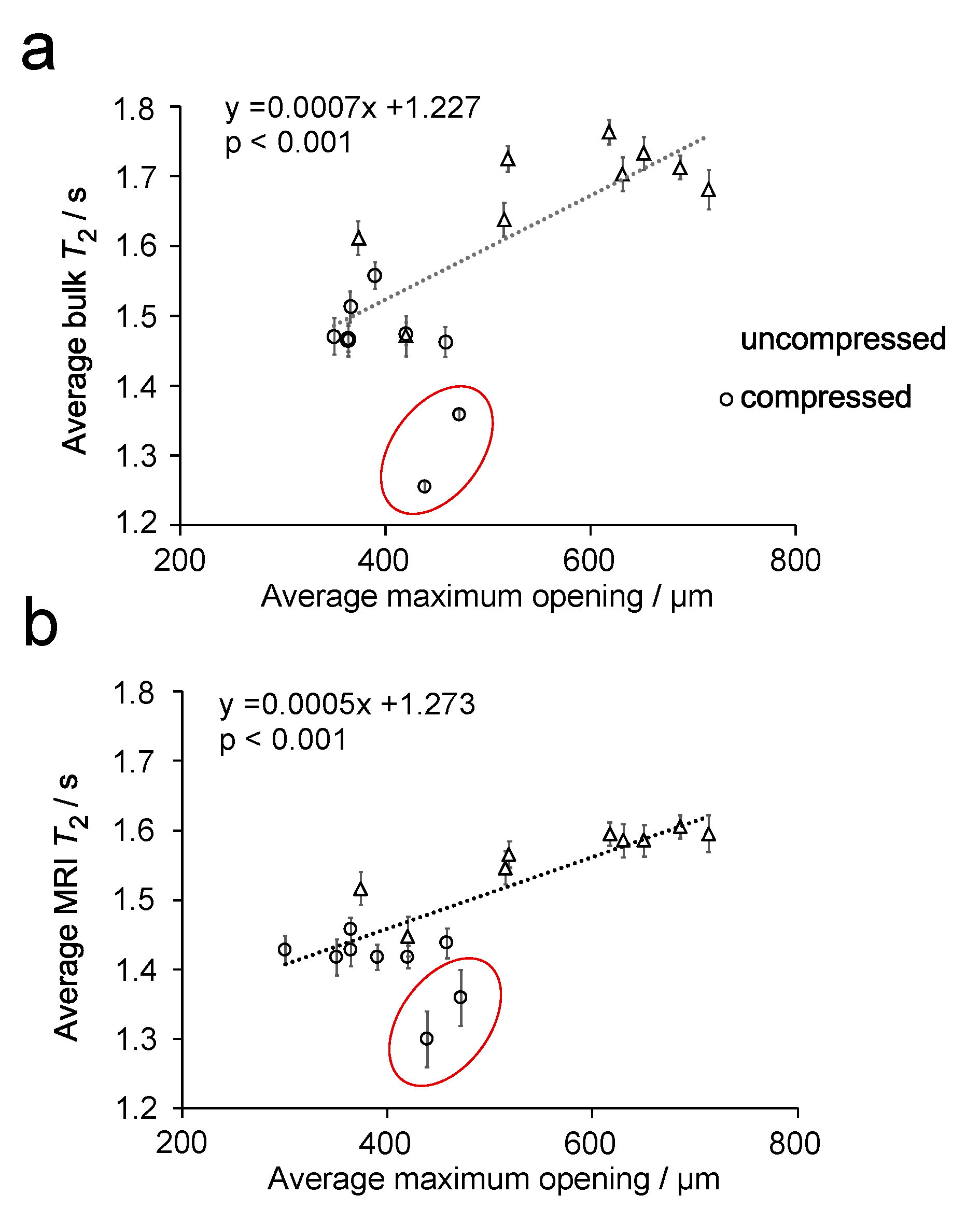

| Plug | Number of Pores |
|---|---|
| Uncompressed plug | 9135 |
| 60% compressed plug | 3051 |
| Plug | Average Maximum Opening/µm | Average T2 from MRI/s | Average Bulk T2/s |
|---|---|---|---|
| Uncompressed plug | 620 ± 92 | 1.63 ± 0.04 | 1.76 ± 0.01 |
| 60% compressed plug | 391 ± 63 | 1.45 ± 0.04 | 1.55 ± 0.02 |
Publisher’s Note: MDPI stays neutral with regard to jurisdictional claims in published maps and institutional affiliations. |
© 2021 by the authors. Licensee MDPI, Basel, Switzerland. This article is an open access article distributed under the terms and conditions of the Creative Commons Attribution (CC BY) license (https://creativecommons.org/licenses/by/4.0/).
Share and Cite
Cimmarusti, G.M.; Shastry, A.; Boone, M.N.; Cnudde, V.; Braeckman, K.; Brooker, A.D.M.; Robles, E.S.J.; Britton, M.M. Characterization of Open-Cell Sponges via Magnetic Resonance and X-ray Tomography. Materials 2021, 14, 2187. https://doi.org/10.3390/ma14092187
Cimmarusti GM, Shastry A, Boone MN, Cnudde V, Braeckman K, Brooker ADM, Robles ESJ, Britton MM. Characterization of Open-Cell Sponges via Magnetic Resonance and X-ray Tomography. Materials. 2021; 14(9):2187. https://doi.org/10.3390/ma14092187
Chicago/Turabian StyleCimmarusti, Gabriele M., Abhishek Shastry, Matthieu N. Boone, Veerle Cnudde, Karl Braeckman, Anju D. M. Brooker, Eric S. J. Robles, and Melanie M. Britton. 2021. "Characterization of Open-Cell Sponges via Magnetic Resonance and X-ray Tomography" Materials 14, no. 9: 2187. https://doi.org/10.3390/ma14092187
APA StyleCimmarusti, G. M., Shastry, A., Boone, M. N., Cnudde, V., Braeckman, K., Brooker, A. D. M., Robles, E. S. J., & Britton, M. M. (2021). Characterization of Open-Cell Sponges via Magnetic Resonance and X-ray Tomography. Materials, 14(9), 2187. https://doi.org/10.3390/ma14092187







